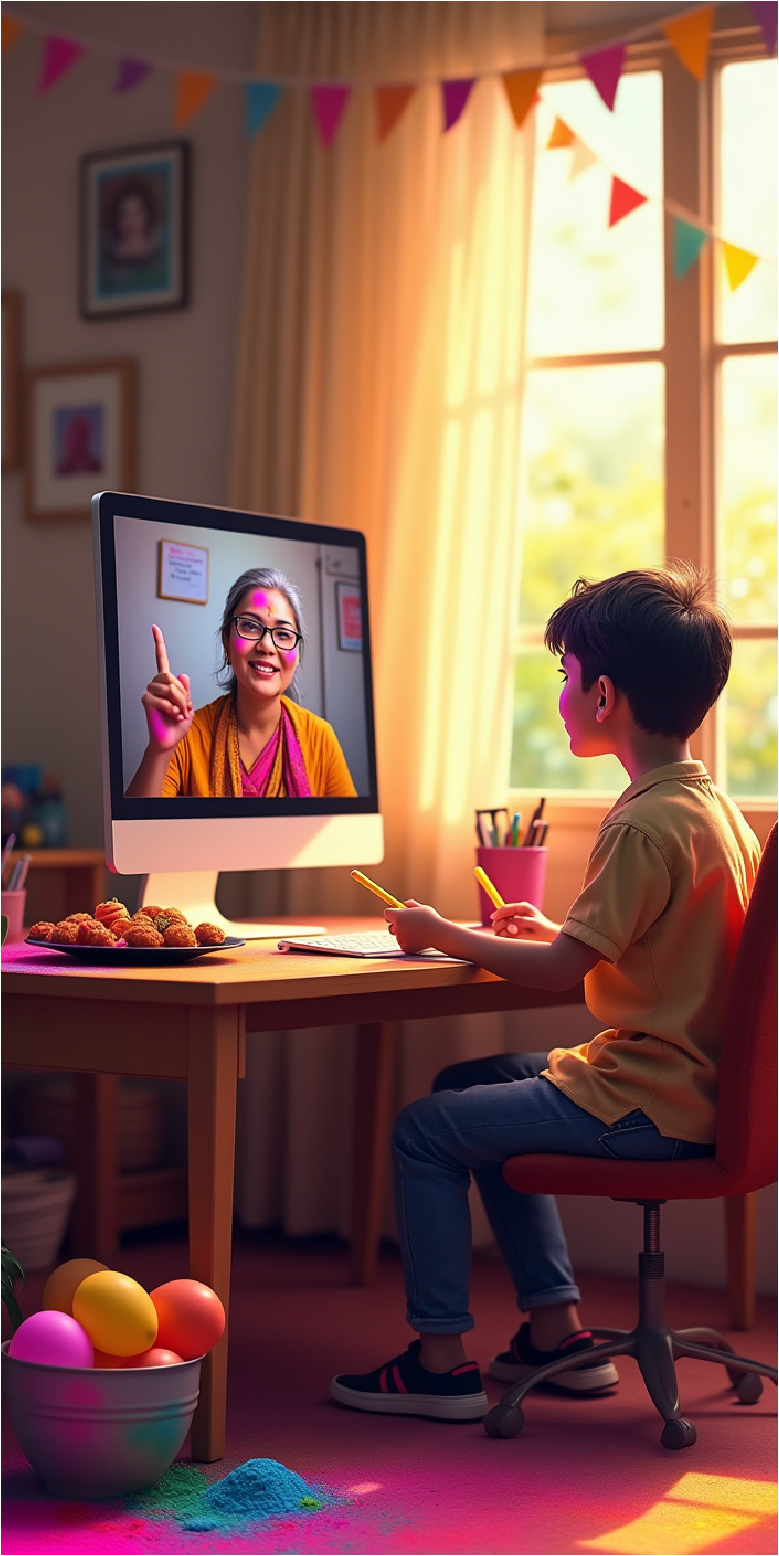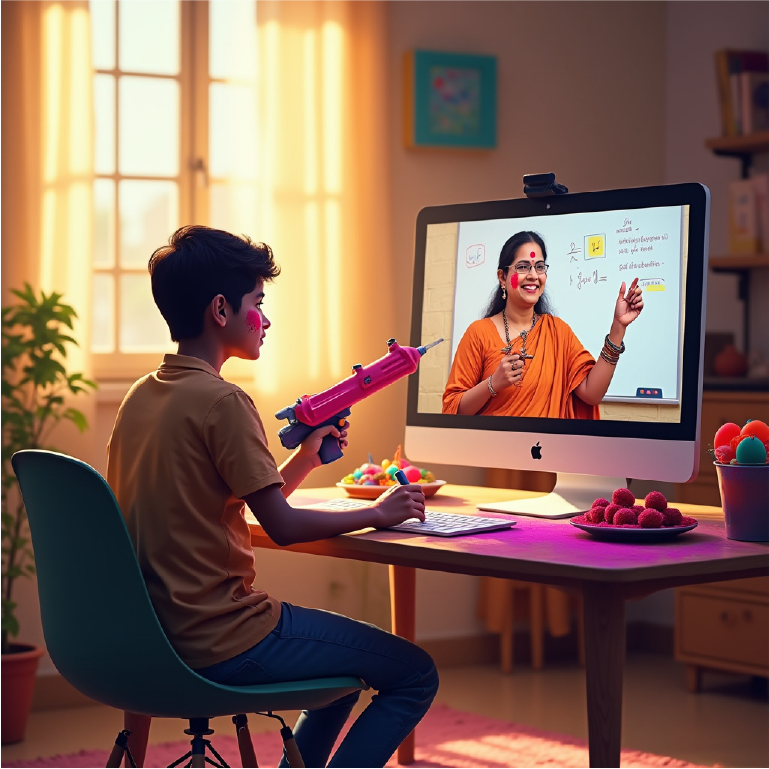Holi, the festival of colors, embodies joy, unity, and renewal. Its vibrant hues symbolize the triumph of good and the spirit of togetherness, a spirit that seamlessly translates into the realm of online education. Just as Holi bridges social divides, online learning connects educators and students across geographical boundaries. This festive season, educators can infuse the essence of Holi into virtual classrooms, transforming them into engaging and memorable learning spaces.
In the digital age, maintaining student engagement in online settings is crucial. Holi’s core values—joy, unity, and renewal—offer a framework for creating a welcoming and interactive virtual environment. Educators can initiate virtual icebreakers, encouraging students to share Holi memories or discuss color symbolism, fostering a sense of community.
Visually, Holi’s vibrant colors can enhance online learning. Educators can incorporate colorful presentations, and digital rangoli designs, and encourage student-created digital artwork. This not only adds festivity but also stimulates creativity and visual learning.
Storytelling, a key Holi tradition, provides another avenue for engagement. Educators can share the festival’s origins, discuss its cultural significance, or prompt students to create their own Holi-themed narratives, enriching cultural understanding and language skills.
Beyond cultural enrichment, Holi can serve as a springboard for academic exploration. Science educators can delve into color chemistry, math educators can explore rangoli patterns, and history educators can examine the festival’s historical context.
Virtual Holi celebrations, including dress-up days and open mic events, can foster community and create a fun learning environment. By integrating Holi’s spirit into online classrooms, educators can craft unique learning experiences that transcend physical distance, celebrating knowledge, creativity, and unity.

1. The Importance of Bringing Festivity into Online Learning
Traditional classrooms celebrate festivals through decorations, cultural activities, and interactive sessions. However, in an online setup, educators must take extra steps to bring the festive spirit into virtual learning spaces. Celebrating Holi in online classrooms:
- Helps students connect with their cultural roots, regardless of their location.
- Makes learning more enjoyable and engaging.
- Encourages creativity and participation.
- Strengthens the teacher-student bond through shared experiences.
By incorporating Holi-themed activities, educators can create an interactive and immersive learning environment that enhances student interest and retention.
2. Holi-themed interactive Quizzes & Games
Gamification is an excellent way to make online learning exciting. Holi-themed quizzes and games can make lessons fun while reinforcing subject knowledge. Some ideas include:
Holi Trivia Quiz
Use platforms like Kahoot, Quizizz, or Google Forms to create engaging quizzes. Some sample questions could be:
- What is the significance of Holi in Hindu mythology?
- Which natural ingredients were traditionally used to make Holi colors?
- How is Holi celebrated in different regions of India?
Color Matching Game
- Use digital tools like Google Jamboard to create a color-matching game where students learn about the significance of different colors in Holi and their symbolic meanings.
Word Association Game
- Provide students with a list of Holi-related words (e.g., gulal, bonfire, spring, Rang Panchami) and ask them to form creative sentences or short stories using those words.
These activities not only make learning fun but also encourage critical thinking and knowledge retention.
3. Digital Rangoli & Art-Based Activities
Since Holi is synonymous with colors, why not let students unleash their creativity through digital art? Here are some ideas:
Design a Virtual Rangoli
- Using tools like Canva, Sketch.io, or Microsoft Paint, students can create digital rangolis and share their designs with the class.
Holi-Themed E-Greeting Cards
- Ask students to design Holi greeting cards using online design tools. They can include meaningful messages, historical facts, or poetry.
Painting with a Scientific Twist
- Science educators can integrate color chemistry into an art lesson. For example, students can learn about primary and secondary colors while virtually mixing paints in a digital simulation.
For more inspiration on Holi-themed art activities, check out this guide.
These artistic activities make lessons more engaging while promoting self-expression and creativity.
4. Storytelling with a Holi Twist
Holi is rich in folklore, making it a great opportunity to introduce creative storytelling activities. Here are some innovative ways to incorporate storytelling into virtual classrooms:
Create Your Own Holi Story
Encourage students to write a short story with Holi as the theme. Some ideas include:
- A futuristic Holi celebration in space.
- A detective story involving missing Holi colors.
- A moral story highlighting the values of friendship and forgiveness, inspired by Holi.
Two Truths and a Myth
Share three Holi-related stories with students, where two are true, and one is a myth. Have students guess which one is false. This can be a fun way to learn about the history and significance of the festival.
Role-Playing in Breakout Rooms
Using Zoom or Google Meet breakout rooms, assign students different roles (e.g., Prahlad, Holika, Radha, Krishna) and ask them to reenact the Holi story in their own words.
Storytelling not only improves language and communication skills but also makes history and culture come alive for students.

5. The Science of Colors: DIY Experiments for Virtual Classrooms
For science educators, Holi is an excellent time to introduce fun and engaging experiments related to colors. Some interesting online activities include:
pH Indicator Experiment
Demonstrate how turmeric changes color when mixed with an acidic or basic substance. Students can observe this virtually through video demonstrations or animations.
Color Mixing Challenge
Use digital drawing tools to show how mixing primary colors results in secondary colors. Students can experiment with different color combinations and predict the outcomes.
Eco-Friendly Colors Discussion
Assign students to research the benefits of using natural colors versus synthetic colors and present their findings in a slideshow.
These hands-on activities help students understand scientific concepts while staying engaged in a festive learning environment.
6. Virtual Holi Celebration: Engaging the Online Classroom
To make Holi celebrations more lively in an online setting, educators can organize fun and engaging virtual activities. Some ideas include:
Holi Dress Code Day
Ask students to wear bright colors during the virtual class and share pictures in a collaborative digital space.
Virtual Open Mic Event
Encourage students to perform Holi-themed poetry, music, or personal festival experiences in a virtual open mic session.
Holi-Themed Discussion Panels
Invite guest speakers to talk about the cultural, historical, or environmental aspects of Holi.
Celebrating Holi virtually fosters a sense of community and excitement, making students feel more connected despite being in a digital classroom.
Final Thoughts: Spreading the Colors of Learning
Holi, more than a festival of colors, is a powerful lesson in embracing diversity, joy, and the promise of new beginnings. These values resonate deeply within the heart of education, particularly in today’s dynamic online learning landscape. As educators navigating the digital realm, we hold the unique ability to transform learning into an exciting, vibrant experience by weaving festive themes like Holi into our lessons.
The essence of Holi lies in its ability to dissolve barriers and celebrate unity amidst diversity. Just as the festival’s colors blend and mingle, creating a tapestry of joy, our online classrooms can become spaces where diverse perspectives converge, fostering a rich and inclusive learning environment. We can use the spirit of Holi to encourage collaboration, respect, and understanding among students from different backgrounds, creating a sense of belonging that transcends geographical boundaries.
Moreover, Holi’s emphasis on joy and renewal can inject a much-needed sense of enthusiasm into online learning. By incorporating interactive activities, engaging visuals, and creative projects inspired by the festival, we can reignite students’ curiosity and make learning a truly enjoyable experience. Just as the vibrant colors of Holi spread happiness, we can spread the colors of knowledge, creativity, and enthusiasm, painting our virtual classrooms with a sense of wonder and excitement.
Let us harness the power of festive themes like Holi to create online learning experiences that are not only informative but also transformative. By embracing diversity, celebrating joy, and fostering a spirit of renewal, we can empower our students to become lifelong learners, equipped with the knowledge, skills, and values they need to thrive in an ever-changing world. Happy Holi!
FAQs
1. How can online educators make Holi celebrations engaging for students?
Educators can incorporate Holi-themed quizzes, storytelling sessions, digital rangoli-making, and virtual dress-up days to create an immersive learning experience.
2. What are some interactive Holi games for virtual classrooms?
Games like Holi trivia quizzes, color-matching challenges, and storytelling contests can make virtual classes more enjoyable.
3. How can educators use Holi to teach science concepts?
Teachers can demonstrate pH color changes, discuss natural vs. synthetic colors, and conduct color-mixing experiments in virtual science classes.
4. What digital tools can be used for Holi-themed activities?
Platforms like Kahoot, Google Jamboard, Canva, and Sketch.io can be used for quizzes, digital art, and interactive activities.
5. How can Holi celebrations strengthen teacher-student relationships?
Festive activities create shared experiences, fostering a sense of community and making learning more enjoyable for both educators and students.



